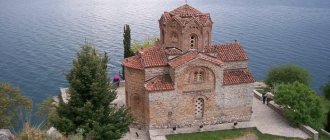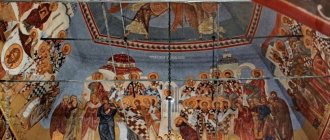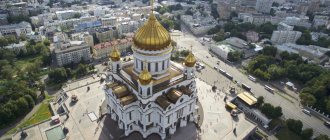Ecumenical Councils - what are they?
The original meaning of the word “cathedral” is “meeting, congress.” Today, the word is used in this meaning only in the church lexicon. Ecumenical councils are meetings of the hierarchs of the Orthodox Church in its universal completeness for the purpose of discussing church-wide dogmatic, canonical and disciplinary issues.
First Ecumenical Council (Orthodox icon)
The participants of the council are mostly bishops representing individual Local Churches. Bishops are the successors of the apostles, bearers of special grace. Therefore, their congregation makes decisions not on its own, but under the guidance of the Holy Spirit. In this regard, the provisions of the Ecumenical Councils are recognized as true and binding for all autocephalous Churches. Thus, the Ecumenical Council is the body of the highest church authority.
For a Council to receive Ecumenical status, it must pass the test of time. It is necessary that all Local Churches recognize its decrees as consistent with God's Law and the norms of church government. Some meetings, under pressure from emperors or influential bishops, made decisions that were contrary to Orthodox doctrine. Subsequently, such Councils were rejected by the Church. They were assessed as illegitimate, and their decisions were not accepted by world Christianity. These cathedrals are usually called “robber cathedrals”.
Fourth Holy Assembly
The Fourth Ecumenical Council, held in Chalcedon, was convened specifically in order to eliminate all the Monophysite disputes that began to spread around the church. The Holy Assembly, consisting of 650 bishops, defined the only true teaching of the church and rejected all existing false teachings. The Fathers decreed that the Lord Christ is the true, unshakable God and true man. According to his deity, he is eternally reborn from his father; according to his humanity, he was brought into the world from the Virgin Mary, in all likeness to man, except for sin. At the Incarnation, the human and the divine were united in the body of Christ unchangeably, inseparably and inseparably.
It is worth noting that the heresy of the Monophysites brought a lot of evil to the church. The false teaching was not completely eradicated by conciliar condemnation, and for a long time disputes continued to develop between the heretical followers of Eutyches and Nestorius. The main reason for the controversy was the writings of three followers of the church - Fyodor of Mopsuet, Willow of Edessa, Theodoret of Cyrus. The mentioned bishops were condemned by Emperor Justinian, but his decree was not recognized by the Universal Church. Therefore, a dispute arose about the three chapters.
Ecumenical Councils of the Orthodox Church
How many Ecumenical Councils have there been? There are seven of these in Orthodoxy. The first took place in 325 in Nicaea, under Emperor Constantine the Great. The Council recognized as heretical the Arian doctrine of the createdness of Christ, which denied His coexistence with God the Father. The corresponding dogmas were proclaimed, and 7 theses of the Creed were adopted. The congress also approved the time for celebrating Easter.
The venue for the Second Ecumenical Council was Constantinople. This happened in 381 (under Theodosius the Great). The heresy that did not recognize the Divinity of the Holy Spirit was condemned. Accordingly, the dogmas about this Person of the Holy Trinity were accepted and the Creed was finally formulated.
The Third Council took place in 431, during the reign of Theodosius the Lesser. The venue was Ephesus. The Church then exposed the heresy of Nestorianism. She taught that Christ was a man who had a special grace-filled relationship with God. Accordingly, the Virgin Mary was not recognized by heretics as the Mother of God. The Council accepted the dogmas about the two natures (God and man) of the Lord, as well as the fact that Mary was the Mother of God.
The Fourth Council took place in 451 in the city of Chalcedon. Then Emperor Marcian ruled. Church hierarchs condemned the heresy of Monophysitism, which denied the human nature of Christ. The dogma of the indissoluble and unmerged union in the Savior of the nature of the Divine and man was proclaimed.
The 5th and 6th Ecumenical Councils of the Orthodox Church were again held in the capital of Byzantium. This happened in 553 (Justinian I) and 680 (Constantine Pogonatus). The Church then confirmed the decisions of previous Councils, and also condemned several false creeds. Among them is Arianism, which did not accept the dogma of the consubstantiality of Christ and God the Father. And also monothelitism, which denied the presence of a human will in Christ. The doctrine was accepted that the Savior had both Divine and human wills, which were in harmony with each other.
Archpriest Vladislav Tsypin
(From the book: Course of Church Law. Klin, 2002. SS.261–270)
Catholicity of the Church
The Church of Christ is a Divine institution in which the salvation and deification of man is accomplished. One of the properties of the Church, reflected in the 9th Symbol of Faith, is catholicity, conciliarity. The catholicity of the Church is manifested not only in the fact that it is not limited by space and embraces the whole world, but also in the fact that each of its living parts, possessing the fullness of the gifts of the Holy Spirit, mystically identical with the whole Church, is the Church. The community of the faithful, led by a bishop who is in communion with other bishops, is the Church, and there is no incompleteness in it. All the more self-sufficient in mystical and ecclesiological terms is the local Church, headed by a host of bishops and therefore not having the need to turn to the help of other Churches to maintain the apostolic succession of episcopal power.
At the same time, the catholicity of the Church is also manifested in the fact that in the local Church, which breaks communion with other Churches, falls out of the universal church Body, its God-created structure is damaged, and it is ultimately deprived of the grace-filled gifts of the Holy Spirit, for these gifts were sent down to the apostolic host, united by love and therefore participating in the Trinity Divine life: “Let all be one; just as You, Father, are in Me, and I in You, so that they also may be one in Us” (John 17:21).
In nineteenth-century canonical scholarship and modern eucharistic ecclesiology, there has been a tendency to emphasize the local character of the Church at the expense of its universality. In the old manuals on church law, even in the best of them, the description of government in the local Church pushes into the background the description of the hierarchical structure of the Universal Church. For example, Professor A. S. Pavlov considers Ecumenical Councils only as one of the ways of communication between autocephalous Churches. Such a tilt in the church-canonical consciousness is probably associated with a weakening of the intensity of the experience of the universal unity of the Church of Christ, characteristic of modern times, which coincides with the synodal period of our church history.
The views of modern Eucharistic ecclesiology are especially sharply expressed by Archpriest N. Afanasyev. In the book “The Church of the Holy Spirit” he argues that the Holy Scripture knows only the local Church, and the idea of the Universal Church was first expressed by Saint Cyprian of Carthage. Meanwhile, did the Lord say about the local Church: “I will build My Church, and the gates of hell will not prevail against it” (Matthew 16:18).
We find a deep understanding of the relationship between the universal and local principles in the Catholic Church from Archbishop Vasily (Krivoshein). “The Local Church,” he wrote, “is not only a part of the Catholic Universal Church, but its complete manifestation. Entirely undiminished identification in a specific place. It is the Catholic Church in a certain place, identical with the Ecumenical Catholic Church, which exists only in its local manifestations, but at the same time (and here we encounter a theological antinomy) it is not identical with the Ecumenical Church, it is different from it. The Trinity analogy can help us gain some insight into this ecclesiological paradox. And we can use such analogies, since the life of the Church is a reflection of the Trinity Divine Life, but we must do this with caution, remembering the important difference that the Divine Life is threefold, while there are not three local Churches, but many. We can thus say that since the Divine Persons - Father, Son and Holy Spirit - are not parts of the Most Holy Trinity, but in each of Them the whole Divinity is fully revealed, so that each Divine Person is the true God, we cannot however say that each person is the Most Holy Trinity or identical with It. Likewise, the fullness of the Catholic Church is revealed in each local Church, which are not “parts” of the Ecumenical, but cannot, however, simply be identified with it.”
Highest authority in the Church
The only and internally unified Body of the Catholic Church also has one Head - Jesus Christ (Eph. 5:23; Col. 1:18). Orthodox teaching knows no other than the Lord, the Head of the Church; this does not mean, however, that the earthly Universal Church does not have power exercised by human authority, that the highest power in the Church lies beyond the limits accessible to canonical characteristics. The history of the Church itself, as well as Orthodox ecclesiology, irrefutably testifies: the bearer of such power is the ecumenical episcopate - the successor of the apostolic host. Leading church communities, bishops are in constant canonical communion with each other, thereby realizing communication between local Churches that preserve the unity of the Orthodox faith and life according to faith.
The forms of this communication can be different. In addition to prayerful communication, which never ceases, in the era of persecution it was carried out through visits by bishops to their fellow churches, exchange of messages, and councils of bishops of individual provinces of the Roman Empire. After the Edict of Milan, councils began to be convened regularly.
Ecumenical Councils
In 325, a council was convened in Nicaea, at which the episcopate from all parts of the state was represented - the First Ecumenical Council. History knows seven Ecumenical Councils, each of which was convened to authoritatively present dogmas and refute heretical false teachings.
The canons do not contain definitions regarding the Ecumenical Councils: their composition, powers, conditions of convening, and the authorities authorized to convene them. And this is no coincidence. Unlike Roman Catholic ecclesiology and canons, which place the Ecumenical Councils in a subordinate position in relation to the Bishop of Rome, Orthodox ecclesiology sees in the Ecumenical Council the highest authority of the earthly Church, which is under the direct guidance of the Holy Spirit, and therefore cannot be subject to strict regulation.
The prototype of the Ecumenical Councils is the Apostolic Council in Jerusalem, described in the “Acts of the Holy Apostles.” Saint Cyril of Alexandria wrote about the Fathers of the First Ecumenical Council: “It was not they who spoke, but the very Spirit of God and the Father.” His words place this Council on a par with the Apostolic Council.
Since there are no canonical definitions of the Ecumenical Council, the main features of the extraordinary, charismatic institution we are considering in the life and structure of the Church can be identified only on the basis of historical data, generalizing the circumstances under which the Councils were convened and took place.
As for the authority that convened them, all seven Councils were convened by emperors. This is an indisputable historical fact, which later Roman Catholic fictions are powerless to refute that the emperors, convening Councils, allegedly carried out the instructions of the popes. But the statement of this fact does not provide any reasonable grounds to deny the possibility of convening a Council on the initiative of other, ecclesiastical authorities. Such a denial would be an unacceptably bold intrusion into the realm of the Holy Spirit.
In terms of their composition, the Ecumenical Councils were predominantly episcopal corporations. This can be seen already from the traditional name of the Councils by the number of bishops who participated in them: the Council of Nicaea went down in history as the Council of the 318 Fathers. Presbyters or deacons were present at Councils as full members only in cases where they represented their bishops, most often the pope and the Patriarchs. Presbyters and deacons also participated in council activities as advisers in the retinue of their bishops. Their voice could be heard at the Council. It is known what a great work Saint Athanasius the Great accomplished at the Council of Nicaea, arriving in Nicaea with his bishop, Saint Alexander of Alexandria. Among the laity, emperors and the highest dignitaries of the state were present at the Councils. But conciliar decisions - oros - were signed only by bishops or their deputies. At the same time, the bishops appeared at the Council as representatives of their local Church and did not express their own opinions, but testified to the faith of their Church. As for the signatures of emperors under the acts of the Ecumenical Councils, they merely conveyed to the oros and canons of the Councils the authority of state laws.
The question of the composition of the Councils was discussed in the Russian church press at the beginning of the 20th century, in connection with preparations for the convening of the Local Council. Although the Ecumenical and Local Councils are authorities of different levels, nevertheless, to a certain extent, the analogy between the composition of one and the other body is valid. Various points of view were expressed in the press. Some authors, mainly from the St. Petersburg “group of 32 priests,” demanded perfect equality of rights at the upcoming Council of clergy and laity with bishops, others wrote, especially sharply Bishop Anthony of Volyn, that only the episcopal composition of the Council is canonical, and to call for participation clergy and laity are not allowed in it.
Archbishop Sergius of Finland (later Patriarch) made a profound analysis of this issue in print. He wrote: “Is it possible, from a strictly canonical point of view, to assert that clergy and laity have the right, on an equal basis with bishops, to participate with a casting vote in regional councils? The answer can only be negative. That the clergy and laity were necessarily present at the Councils and that some of them took the most remarkable part in the deliberations of the Council is true... But to say that this was the church law, obligatory for everyone, that this was required by the rules of St. Ecumenical and 9 Local Councils are impossible. “The Book of Rules” does not contain any legalization for the participation of clergy and laity in regional councils, and on the contrary, ... wherever it talks about councils, ... it speaks only about bishops and never about presbyters, clergy or laity" (IV Ecumenical 19, Trull. 8, VII Om. 6, Carth. 14, 27, 87, 141, 142. Laod. 40, etc.).However, for the sake of unity and peace of the church, Archbishop Sergius considers it an acceptable measure to call clergy and laity to participate in the Council, but “put it participation in such a way that it does not destroy... the basic principle of the canonical system.” To do this, any resolution of the general Council must be submitted for consideration to the Bishops' Conference if it is protested by at least a quarter of all those present at the Council, and to revise a dogmatic-canonical decision, one protesting vote should be enough. Archimandrite (now Archbishop) Peter (L'Huillier) wrote: “The theory according to which Ecumenical Councils represent a kind of “all-class meetings” of the Church, in which various categories of members of the Church should rightfully be represented, is completely alien to the Christian thought of that time. Here again we see a concept peculiar to the Western medieval corporate system."
Local Churches were represented at the Ecumenical Councils with varying degrees of completeness. Only a few people representing the Western Patriarchate took part in them, although the authority of these people was always high. At the VII Ecumenical Council, the representation of the Alexandria, Antioch and Jerusalem Churches was extremely small, almost symbolic. In any case, recognition of the universality of the Council was never conditioned by the proportional representation of all local Churches.
The competence of the Ecumenical Councils was primarily to resolve controversial dogmatic issues. This is the predominant and almost exclusive right of the Ecumenical Councils, and not of the Local Councils. Relying on Holy Scripture and general Church Tradition, the Fathers of the Councils set out the dogmas of faith given by the Savior in Revelation. The dogmatic definitions of the seven Ecumenical Councils, contained in their oros, have thematic unity: they reveal a holistic Trinitarian and Christological teaching. The presentation of dogmas in conciliar symbols and oros is infallible; It is precisely in them that the infallibility of the Church that we profess is revealed.
About the dogmas it is said in the response of the Eastern Patriarchs: “In the Divine dogmas there is never a place for economy or condescension, since they are unshakable and are preserved with all piety by all Orthodox as indestructible; and the one who transgresses the slightest of these dogmas is condemned and anathematized as a schismatic and a heretic, and everyone considers him excommunicated.” In connection with this, the Councils have the right of a final, irrevocable judgment on any teaching that arises in the Church, on the subject of whether it corresponds to Tradition or contradicts it, as well as the right to anathematize false teachers and their adherents.
The importance of the Ecumenical Councils in the disciplinary field is extremely great. The councils issued canons that fixed the customary law of the Church or gave higher, church-wide authority to the decrees of Local Councils. Ecumenical Councils approved the rules of Local Councils and Fathers. They changed and clarified previously held disciplinary definitions.
Finally, the Councils carried out trials of the primates of the autocephalous Churches and other hierarchs not only on charges of heresy, but also in connection with violations of discipline or illegal occupation of church positions. The Ecumenical Councils also had the right to make judgments on the status and boundaries of local Churches.
The question of church acceptance, the reception of the resolutions of the Councils, and, in connection with this, the criteria for the universality of the Council is extremely difficult. It is well known from history that some of the Councils, not recognized as Ecumenical or even directly condemned as predatory, in terms of the number of local Churches represented at them were not inferior to the Councils recognized as Ecumenical, at least to the smallest of them - the First Council of Constantinople.
The Russian thinker A. S. Khomyakov linked the authority of the Councils with the acceptance of its decrees by the Christian people: “Why were these councils rejected,” he wrote about the gatherings of bandits, “which do not represent any external differences from the Ecumenical Councils? The only reason is that their decisions were not recognized as the voice of the Church by all the church people.” But the point of view of A. S. Khomyakov is inconsistent in ecclesiological terms, and if what he said is taken literally, then it is simply incorrect. More than once in the history of the Church there was a minority on the side of truth, while the Christian majority rejected it. In reality, there are, of course, no external criteria for unambiguously determining the universality of the Councils, because there are no external criteria for absolute Truth.
As St. wrote. Maximus the Confessor, “the pious rule holds that those councils are holy and recognized which are confirmed by the correctness of dogmas.” The Monk Maxim also rejected the Caesar-papist tendency to make the ecumenical authority of the Councils dependent on the ratification of their decrees by the emperors: “If the previous Councils were approved by the orders of the emperors, and not by the Orthodox faith,” said the Holy Father, “then let those councils also be accepted that spoke out against unity [Divine] essence, since they were assembled by order of the emperor... All of them, indeed, were assembled by order of the emperors, and yet all were condemned because of the blasphemy of the blasphemous teachings that were established on them.” The claims of Roman Catholic ecclesiology and canons, which make the recognition of conciliar acts dependent on their ratification by the Bishop of Rome, are also untenable.
According to the reasonable remark of Archbishop Peter (L'Huillier), “The Fathers of the Ecumenical Councils never considered that the validity of the decisions made depended on any subsequent ratification... The measures adopted at the Council became binding immediately after the end of the Council and were considered irrevocable.” Historically, the final recognition of the Council as ecumenical belonged to the subsequent Council, and the VII Council was recognized as Ecumenical at the local Council of Constantinople in 879.
The history of the Church knows seven Ecumenical Councils. There is an opinion among the church people according to which there cannot be more than seven Councils, which means, on the one hand, one more of the previously held Councils cannot be recognized as ecumenical in the future, and on the other hand, convening a new Ecumenical Council in the future is impossible. The Grand Duke of Moscow Vasily the Dark told Metropolitan Isidore, who betrayed Orthodoxy at the Florence Council, that everything had already been said at seven Ecumenical Councils and the thought of an eighth Council was wicked.
Professor A. S. Pavlov discussed this topic differently at the end of the 19th century: “At the present time, when separate parts of the Ecumenical Church are in different states, sometimes hostile to each other, an Ecumenical Council seems almost impossible due to political circumstances.”
In the Orthodox theological literature of our time it is almost impossible to come across a point of view that dogmatizes the sevenfold number of Ecumenical Councils. Archbishop Vasily (Krivoshein) claims that the Council of Constantinople in 879 “both in its composition and in the nature of its resolutions... bears all the signs of an Ecumenical Council. All five Patriarchates of the then Church, including the Roman Church, were represented at it, so this Council is the last Council common to both the Eastern and Western Churches. It was attended by 383 Fathers, that is, it was the largest Council since Chalcedon. It was convened as an Ecumenical Council and calls itself in its acts both a great and an Ecumenical Council. And although it was not officially recognized by the Ecumenical Church, for such recognition was usually made at a subsequent Council, but there was none, a number of prominent church figures over the centuries called it the VIII Ecumenical Council, for example, the famous 12th century canonist Theodore Balsamon, Nile of Thessaloniki (XIV century), Nile of Rhodes (XIV century), Simeon of Thessaloniki (XV century), St. Mark of Ephesus, Gennady Scholarius, Dositheus of Jerusalem (XVII century)... By the nature of its activities, the Council of 879-880 also has the features of an Ecumenical Council. Like the Ecumenical Councils, it made a number of decrees of a dogmatic-canonical nature. Thus, he proclaimed the immutability of the text of the Creed without filioque and anathematized everyone who changes it.”
As is known, the Ecumenical Orthodox Church is now preparing for a Pan-Orthodox Council, without prejudging in advance the question of its status, but leaving open the possibility of recognizing it as ecumenical.
There is reason to believe that the dogmatization of the sevenfold number of Councils is one of the examples of ecclesiological aberration, similar to the doctrine of the pentarchy widespread in Byzantium.
The history of the Church, in addition to the Ecumenical and Local Councils in the proper sense of the word, also knows such church councils that, although by tradition they are classified as local, either in the importance of their decisions or in their composition had greater significance than ordinary Local Councils. These include Local Councils, the rules of which were included in the canonical code, the Councils of Constantinople in 879, 1156, 1157, the Hesychast Councils in Constantinople in 1341, 1347 and 1351, as well as those whose definitions are dogmatic in nature. An example of a Council, which in its composition had a pan-Orthodox significance, is the Great Moscow Council, which condemned Patriarch Nikon (1667).
For more than a thousand years, the Orthodox Church has lived without Ecumenical Councils, although the question of convening a new Ecumenical Council continues to remain open. The permanent bearer of earthly power in the Church is the God-established ecumenical episcopate, headed by the First Hierarchs of the autocephalous Churches, who maintain prayerful and canonical communion.
Metropolitan Sergius (later Patriarch) wrote in a letter to Metropolitan Agathangel: “The meeting of bishops in one place, called the Council, is not the only form, not the only way for the episcopal estate to exercise its general episcopal government powers. The Episcopal Council is only the most convenient way for the episcopal estate to discuss church affairs with general reasoning and to make general episcopal decisions... But the general decision of the bishops has exactly the same force and bindingness even when they, remaining in their places, discuss the matter and decide a common decision, talking with each other, for example, by long-distance telephone... or communicating with each other in writing or through a special messenger, as was the case with the Apostle Paul and the Corinthian primates.”
The judgment of Metropolitan Sergius directly related to Russian church affairs, however, it is of a fundamental canonical nature, and its significance goes beyond the boundaries of one local Church.
Seventh Ecumenical Council
In the 8th century, the Church in Byzantium suffered from the heresy of iconoclasm, to which even some emperors were susceptible. Thus, Leo the Isaurian issued decrees on the mass destruction of holy images and the cruel persecution of their admirers. The majority of the people continued to worship images of the Lord and saints, which sometimes led to uprisings. Saint John of Damascus and other prominent theologians spoke out against heresy.
Leo's successor, Constantine Kopronymus, continued his iconoclastic policy. He sought mainly to influence bishops and other monastics. After all, many of them still defended the veneration of holy images. The emperor resorted to executing monks and closing monasteries. And in 754, with heretical bishops, he organized a church council, which condemned the veneration of icons. Archbishop Averky (Taushev) notes:
“All the then zealots of Orthodoxy had to hear a lot of curses from the face of this Council. Many false accusations were brought against them. The Council based its false iconoclastic speculations on fictitious tales and false sayings of the Fathers of the Church.”
The persecution eased somewhat under the next ruler, Leo IV. After his death, the throne was taken by the emperor's wife Irina. She was a pious icon-worshipper, for which she was in disgrace for a long time. Having become the sole ruler, Irina stopped the repressions. However, this was not enough for the triumph of Truth.
Following the instructions of the newly elected Patriarch Tarasius, Irina convened the 7th Ecumenical Council, which exposed the previous iconoclastic meeting and approved the dogma of the veneration of holy images. All this was supported by numerous arguments that were based on the Holy Scriptures and Tradition, as well as numerous testimonies of miracles from icons. The Council decided:
“We determine that holy and honest icons should be offered for veneration in the same way as images of the honest and life-giving Cross... Those who look at these icons are awakened to the memory of the very prototypes, acquire more love for them... The honor given to the icon relates to its prototype , and the one who worships the icon worships the person depicted on it.”
The Council also adopted 22 canonical rules. He completed the era of the Ecumenical Councils and the process of formation of Orthodox doctrine.
Sixth Holy Assembly
The history of the Ecumenical Councils says that the struggle of orthodox Christians with heretics lasted for quite a long time. The sixth council (Trullo) was convened in Constantinople, at which the truth was finally to be established. At the meeting, which brought together 170 bishops, the teachings of the Monothelites and Monophysites were condemned and rejected. In Jesus Christ two natures were recognized - divine and human, and, accordingly, two wills - divine and human. After this council, Monothelianism fell, and for about fifty years the Christian church lived relatively calmly. New vague trends appeared later regarding the iconoclastic heresy.
Ecumenical Councils in Orthodoxy and Catholicism
Eastern and Western Christianity have developed different views on Ecumenical Councils and their number. All 7 Councils recognized by Orthodoxy were held within 9 centuries after the birth of Christ. That is, they took place until the division of the united Church into Orthodox and Catholic. Accordingly, all these Councils are recognized in the West.
However, subsequently Catholics convened many other Councils, which are not recognized by Orthodoxy. Thus, according to Western Christianity, the total number of Ecumenical Councils is 21. Moreover, the last of them was held in the 60s of the last century (Vatican II).
Separately, it is worth mentioning the Council, which Catholics consider Ecumenical, calling it the Fourth of Constantinople. It was convened in 869 by the forces of the Byzantine Emperor Basil I and Pope Adrian II. On the one hand, this meeting took place before the official division of the Churches, in the capital of Orthodox Byzantium. Moreover, the meeting place was the main Orthodox church of the empire (Hagia Sophia).
On the other hand, the congress was held by the emperor in order to please the Roman throne. Its results were unacceptable concessions to the West. For example, the deposition of Patriarch Photius and the recognition of the primacy of the Pope in key church issues. However, soon the church policy of Vasily I changed and the actions of the Council were forgotten. Thus, he was not accepted in Orthodoxy.
The division of the Christian Church into Eastern and Western is one of the reasons for the wary attitude in Orthodoxy towards the potential holding of the Eighth Ecumenical Council. There are no dogmatic prohibitions on this. After all, Councils are one of the forms of self-government and self-organization of the Church. They are convened when there is a need to make important church-wide decisions.
Rules of True Faith
The Holy Fathers left behind canons or, in other words, rules of the Ecumenical Councils, which should guide the entire church hierarchy and the believers themselves in their church and personal life.
Basic rules of the first holy meeting:
- Persons who have castrated themselves are not accepted into the clergy.
- New believers cannot be promoted to sacred degrees.
- A clergyman cannot have a woman in his house who is not his close relative.
- Bishops must be elected by bishops and confirmed by the metropolitan.
- A bishop must not accept into communion persons who have been excommunicated by another bishop. The rule commands that episcopal assemblies be convened twice a year.
- The supreme authority of some dignitaries over others is confirmed. It is prohibited to appoint a bishop without a general meeting and the permission of the metropolitan.
- The bishop of Jerusalem is similar in degree to the metropolitan.
- There cannot be two bishops in one city.
- Depraved persons cannot be allowed to serve in the priesthood.
- The fallen are cast out from the sacred rank.
- Methods of repentance for those who have departed from the faith are established.
- Every dying person must be guided by the holy mysteries.
- Bishops and clergy cannot move from city to city without permission.
- Clerics cannot engage in usury.
- It is prohibited to kneel on Pentecost and Sunday.
Basic Rules of the Second Holy Assembly:
- All heresy must be anathema.
- Bishops should not extend their authority beyond the boundaries of their area.
- Canons for the acceptance of repentant heretics are established.
- All accusations against church rulers must be investigated.
- The Church accepts those who profess one God.
The basic rule of the third holy assembly: the main canon prohibits the creation of a new creed.
Basic Rules of the Fourth Holy Assembly:
- All believers must observe everything that was decreed at previous councils.
- Admission to a church degree for money is strictly punishable.
- Bishops, clerics and monks should not engage in worldly affairs for the sake of profit.
- Monks should not lead disorderly lives.
- Monks and clerics must not enter into military service or lay rank.
- Clerics should not be tried in secular courts.
- Bishops must not resort to the assistance of civil authorities in ecclesiastical affairs.
- Singers and readers should not marry wives of other faiths.
- Monastics and virgins should not marry.
- Secular dwellings should not be converted into monasteries.
A total of seven Ecumenical Councils produced a whole set of rules that are today available to all believers in special spiritual literature.
Prayers to the Holy Fathers of the Ecumenical Councils
Troparion to the Holy Fathers of the Six Ecumenical Councils, tone 8
Glorified art thou, O Christ our God,/ our founding fathers of light on earth,/ and through them instructing all of us to truer faith, // Most gracious, glory to Thee.
Translation:
Glorified are You, Christ our God, as you established the lights on earth of our fathers and through them guided us all on the path of true faith, O Most Merciful, glory to You!
Kontakion to the Holy Fathers of the Six Ecumenical Councils, tone 8
Apostle preaching and father of dogma/ Seal to the one faith of the Church,/ even wearing the robe of truth, which came from above theology,// corrects and glorifies the great piety ness.
Translation:
The preaching of the Apostles and Fathers established the dogmas of a single faith for the Church; and she, wearing the robe of truth, woven from heavenly Theology, correctly teaches and glorifies piety the great sacrament.
Troparion to the Holy Fathers of the Seventh Ecumenical Council, tone 2
We worship your most pure image, O Good One, / asking forgiveness of our sins, O Christ God: / for it was your will that you should ascend in flesh to the Cross, / that you might deliver from the work of the enemy life./ Thus we cry out to You in gratitude:/ You have filled all with joy, O our Savior ,// came to save the world.
Translation:
We worship Your most pure image, O Good One, asking forgiveness of our sins, O Christ God. For You voluntarily deigned to ascend in the flesh to the Cross in order to deliver those created by You from slavery to the enemy. Therefore, we gratefully cry out to You: “You have filled everything with joy, our Savior, who came to save the world!”
The Meaning of Holy Assemblies
The Seven Ecumenical Councils are of paramount importance in the development of the basic tenets of Christian doctrine, on which all modern faith is based.
- The first one affirmed the divinity of Christ, his equality with the Father God.
- The second condemned the heresy of Macedonius, who rejected the divine essence of the Holy Spirit.
- The third one eliminated the heresy of Nestorius, who preached about the split faces of the God-man.
- The fourth dealt the final blow to the false teaching of Monophysitism.
- The fifth - completed the defeat of heresy and established the confession of two natures in Jesus - human and divine.
- The sixth - condemned the Monothelites and decided to confess two wills in Christ.
- The seventh - overthrew the iconoclastic heresy.
The years of Ecumenical Councils made it possible to introduce certainty and completeness into orthodox Christian teaching.
Documents and literature
- Materials of the DECR MP Archive. Translations of materials from preliminary meetings:
- Minutes of the Preparatory Commission of the Holy Orthodox Churches, meeting in the Holy Great Vatopedi Monastery on the Holy Mountain on June 8-23, 1930: Trans.
from Greek , Constantinople, 1930 (printed). - Projects of effective documents of the Commission at the Holy Synod of the Russian Orthodox Church on the development of a catalog of topics of the Pan-Orthodox Pre-Council
, M., 1968 (machined). - On the roads to the Great Council: Report of the Inter-Orthodox Preparatory Commission on 6 topics of the 1st stage
, Chambesy, 1971. - Inter-Orthodox Preparatory Commission for the Holy and Great Council of July 16-28, 1971
, Chambesy, 1973. - 1st Pan-Orthodox pre-conciliar meeting. Chambesy, November 21-28, 1976: Protocols-texts
, 1976. - Essay on the Holy Bulgarian Orthodox Church: "Orthodox Monasticism"
, Chambesy, 1982. - 2nd Pan-Orthodox Pre-Conciliar Conference
, Chambesy, 1985. - Inter-Orthodox Preparatory Commission February 15-23, 1986
, Chambesy. - 3rd Pan-Orthodox Pre-Conciliar Conference: Protocols and Texts
, Chambesy, October 28-November 6, 1986. - Inter-Orthodox Preparatory Commission for the Holy and Great Council November 10-17, 1990
, Chambesy, 1991. - Inter-Orthodox Preparatory Commission of the Holy and Great Council, November 7-13, 1993
, Chambesy, 1994.
, 1961, No. 11, p. 5-29.
, 1964, No. 12, p. 1-5.
, 1968, No. 7, p. 7-8.
, 1999, No. 3, p. 29-30.
, 2002, No. 2 (19), pp. 54-199.
A few words from history
In the early centuries (from the Nativity of Christ), any church meeting was called a cathedral. A little later (in the 3rd century AD), this term began to denote meetings of bishops to resolve important issues of a religious nature.
After Emperor Constantine proclaimed tolerance towards Christians, the highest clergy were able to periodically meet in a common cathedral. And the church throughout the empire began to hold Ecumenical Councils.
Representatives of the clergy of all local churches took part in such meetings. The head of these councils, as a rule, was appointed by the Roman Emperor, who gave all important decisions made during these meetings the level of state laws.
The emperor was also authorized to:
- convene councils;
- make monetary contributions towards some of the costs associated with each meeting;
- designate a venue;
- maintain order through the appointment of their officials and so on.
Description
Orthodox Ecumenical Councils were initially important events for the Christian world. Each time, issues were considered that subsequently influenced the course of the entire church history.
There is less need for such activities in the Catholic faith because many aspects of the church are regulated by a central religious leader, the Pope.
The Eastern Church - the Orthodox - has a deeper need for such unifying meetings of a large-scale nature. Because quite a lot of questions also accumulate and they all require solutions at an authoritative spiritual level.
In the entire history of Christianity, Catholics currently recognize 21 Ecumenical Councils that have taken place, while Orthodox Christians recognize only 7 (officially recognized) ones, which were held back in the 1st millennium after the Nativity of Christ.
Each such event necessarily examines several important religious topics, different opinions of authoritative clergy are brought to the attention of participants, and the most important decisions are made unanimously, which then have an impact on the entire Christian world.








